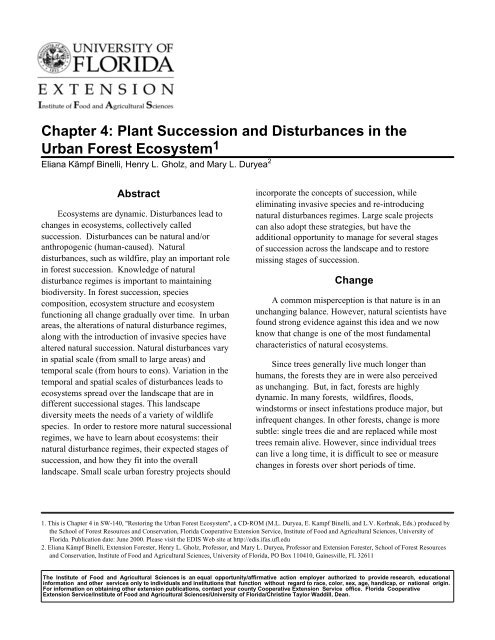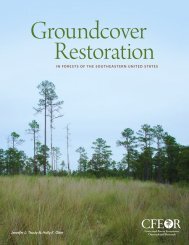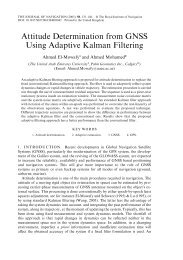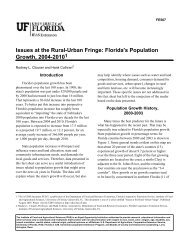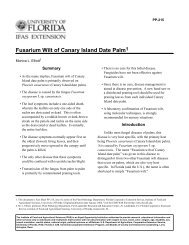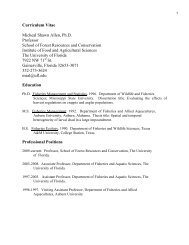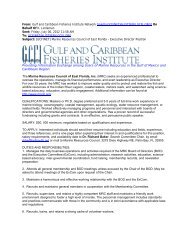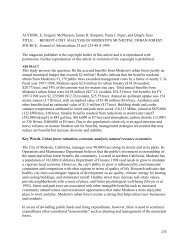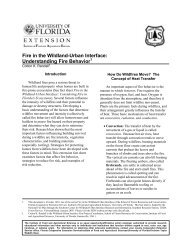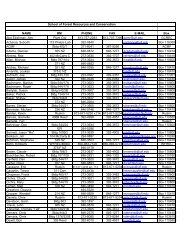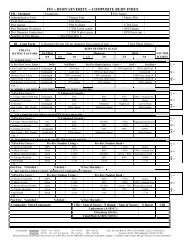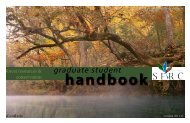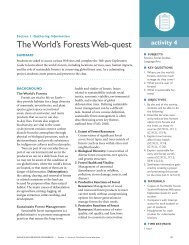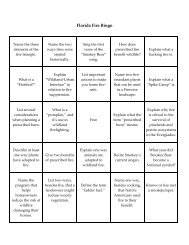Chapter 4: Plant Succession and Disturbances in the Urban Forest ...
Chapter 4: Plant Succession and Disturbances in the Urban Forest ...
Chapter 4: Plant Succession and Disturbances in the Urban Forest ...
Create successful ePaper yourself
Turn your PDF publications into a flip-book with our unique Google optimized e-Paper software.
<strong>Chapter</strong> 4: <strong>Plant</strong> <strong>Succession</strong> <strong>and</strong> <strong>Disturbances</strong> <strong>in</strong> <strong>the</strong><br />
<strong>Urban</strong> <strong>Forest</strong> Ecosystem 1<br />
Eliana Kämpf B<strong>in</strong>elli, Henry L. Gholz, <strong>and</strong> Mary L. Duryea 2<br />
Abstract<br />
Ecosystems are dynamic. <strong>Disturbances</strong> lead to<br />
changes <strong>in</strong> ecosystems, collectively called<br />
succession. <strong>Disturbances</strong> can be natural <strong>and</strong>/or<br />
anthropogenic (human-caused). Natural<br />
disturbances, such as wildfire, play an important role<br />
<strong>in</strong> forest succession. Knowledge of natural<br />
disturbance regimes is important to ma<strong>in</strong>ta<strong>in</strong><strong>in</strong>g<br />
biodiversity. In forest succession, species<br />
composition, ecosystem structure <strong>and</strong> ecosystem<br />
function<strong>in</strong>g all change gradually over time. In urban<br />
areas, <strong>the</strong> alterations of natural disturbance regimes,<br />
along with <strong>the</strong> <strong>in</strong>troduction of <strong>in</strong>vasive species have<br />
altered natural succession. Natural disturbances vary<br />
<strong>in</strong> spatial scale (from small to large areas) <strong>and</strong><br />
temporal scale (from hours to eons). Variation <strong>in</strong> <strong>the</strong><br />
temporal <strong>and</strong> spatial scales of disturbances leads to<br />
ecosystems spread over <strong>the</strong> l<strong>and</strong>scape that are <strong>in</strong><br />
different successional stages. This l<strong>and</strong>scape<br />
diversity meets <strong>the</strong> needs of a variety of wildlife<br />
species. In order to restore more natural successional<br />
regimes, we have to learn about ecosystems: <strong>the</strong>ir<br />
natural disturbance regimes, <strong>the</strong>ir expected stages of<br />
succession, <strong>and</strong> how <strong>the</strong>y fit <strong>in</strong>to <strong>the</strong> overall<br />
l<strong>and</strong>scape. Small scale urban forestry projects should<br />
<strong>in</strong>corporate <strong>the</strong> concepts of succession, while<br />
elim<strong>in</strong>at<strong>in</strong>g <strong>in</strong>vasive species <strong>and</strong> re-<strong>in</strong>troduc<strong>in</strong>g<br />
natural disturbances regimes. Large scale projects<br />
can also adopt <strong>the</strong>se strategies, but have <strong>the</strong><br />
additional opportunity to manage for several stages<br />
of succession across <strong>the</strong> l<strong>and</strong>scape <strong>and</strong> to restore<br />
miss<strong>in</strong>g stages of succession.<br />
Change<br />
A common misperception is that nature is <strong>in</strong> an<br />
unchang<strong>in</strong>g balance. However, natural scientists have<br />
found strong evidence aga<strong>in</strong>st this idea <strong>and</strong> we now<br />
know that change is one of <strong>the</strong> most fundamental<br />
characteristics of natural ecosystems.<br />
S<strong>in</strong>ce trees generally live much longer than<br />
humans, <strong>the</strong> forests <strong>the</strong>y are <strong>in</strong> were also perceived<br />
as unchang<strong>in</strong>g. But, <strong>in</strong> fact, forests are highly<br />
dynamic. In many forests, wildfires, floods,<br />
w<strong>in</strong>dstorms or <strong>in</strong>sect <strong>in</strong>festations produce major, but<br />
<strong>in</strong>frequent changes. In o<strong>the</strong>r forests, change is more<br />
subtle: s<strong>in</strong>gle trees die <strong>and</strong> are replaced while most<br />
trees rema<strong>in</strong> alive. However, s<strong>in</strong>ce <strong>in</strong>dividual trees<br />
can live a long time, it is difficult to see or measure<br />
changes <strong>in</strong> forests over short periods of time.<br />
1. This is <strong>Chapter</strong> 4 <strong>in</strong> SW-140, "Restor<strong>in</strong>g <strong>the</strong> <strong>Urban</strong> <strong>Forest</strong> Ecosystem", a CD-ROM (M.L. Duryea, E. Kampf B<strong>in</strong>elli, <strong>and</strong> L.V. Korhnak, Eds.) produced by<br />
<strong>the</strong> School of <strong>Forest</strong> Resources <strong>and</strong> Conservation, Florida Cooperative Extension Service, Institute of Food <strong>and</strong> Agricultural Sciences, University of<br />
Florida. Publication date: June 2000. Please visit <strong>the</strong> EDIS Web site at http://edis.ifas.ufl.edu<br />
2. Eliana Kämpf B<strong>in</strong>elli, Extension <strong>Forest</strong>er, Henry L. Gholz, Professor, <strong>and</strong> Mary L. Duryea, Professor <strong>and</strong> Extension <strong>Forest</strong>er, School of <strong>Forest</strong> Resources<br />
<strong>and</strong> Conservation, Institute of Food <strong>and</strong> Agricultural Sciences, University of Florida, PO Box 110410, Ga<strong>in</strong>esville, FL 32611<br />
The Institute of Food <strong>and</strong> Agricultural Sciences is an equal opportunity/affirmative action employer authorized to provide research, educational<br />
<strong>in</strong>formation <strong>and</strong> o<strong>the</strong>r services only to <strong>in</strong>dividuals <strong>and</strong> <strong>in</strong>stitutions that function without regard to race, color, sex, age, h<strong>and</strong>icap, or national orig<strong>in</strong>.<br />
For <strong>in</strong>formation on obta<strong>in</strong><strong>in</strong>g o<strong>the</strong>r extension publications, contact your county Cooperative Extension Service office. Florida Cooperative<br />
Extension Service/Institute of Food <strong>and</strong> Agricultural Sciences/University of Florida/Christ<strong>in</strong>e Taylor Waddill, Dean.
<strong>Chapter</strong> 4: <strong>Plant</strong> <strong>Succession</strong> <strong>and</strong> <strong>Disturbances</strong> <strong>in</strong> <strong>the</strong> <strong>Urban</strong> <strong>Forest</strong> Ecosystem 2<br />
There are two related aspects of change over<br />
time <strong>in</strong> forests: disturbances <strong>and</strong> succession.<br />
<strong>Disturbances</strong> lead to subsequent changes <strong>in</strong><br />
ecosystems, which are collectively called succession.<br />
This chapter discusses <strong>the</strong> dynamic nature of<br />
forest ecosystems <strong>and</strong> why it is important to<br />
underst<strong>and</strong> disturbances <strong>and</strong> succession <strong>in</strong> order to<br />
manage <strong>and</strong> restore urban forest ecosystems<br />
successfully.<br />
<strong>Disturbances</strong><br />
What are disturbances<br />
Figure 1.1 Photo by Larry Korhnak<br />
<strong>Disturbances</strong> are any event, ei<strong>the</strong>r natural or<br />
human-<strong>in</strong>duced (anthropogenic), that changes <strong>the</strong><br />
exist<strong>in</strong>g condition of an ecosystem. <strong>Disturbances</strong> <strong>in</strong><br />
forest ecosystems affect resource levels, such as soil<br />
organic matter, water <strong>and</strong> nutrient availability, <strong>and</strong><br />
<strong>in</strong>terception of solar radiation. Changes <strong>in</strong> resource<br />
levels, <strong>in</strong> turn, affect plants <strong>and</strong> animals over time,<br />
lead<strong>in</strong>g to succession.<br />
<strong>Disturbances</strong> occur <strong>in</strong> all ecosystems. We often<br />
th<strong>in</strong>k disturbances result only from human activity.<br />
However, <strong>the</strong> def<strong>in</strong>ition of disturbance should not<br />
carry a connotation of negative human impact;<br />
naturally occurr<strong>in</strong>g disturbances are part of every<br />
ecosystem on earth.<br />
What types of disturbances affect forests<br />
Figure 1.2 Photo by Larry Korhnak<br />
Figure 1. Historical fires (1.1) <strong>and</strong> natural hydroperiods<br />
(1.2) are examples of naturally occurr<strong>in</strong>g disturbances<br />
which have been virtually elim<strong>in</strong>ated from urban forest<br />
ecosystems.<br />
All forests are subjected to both natural <strong>and</strong><br />
anthropogenic disturbances. Examples of naturally<br />
occurr<strong>in</strong>g disturbances <strong>in</strong>clude wildfires, w<strong>in</strong>ds<br />
(hurricanes, tornadoes <strong>and</strong> w<strong>in</strong>dstorms), <strong>in</strong>sect <strong>and</strong><br />
disease epidemics, l<strong>and</strong>slides, ice storms, floods <strong>and</strong><br />
droughts (Figure 1).<br />
Examples of anthropogenic disturbances <strong>in</strong>clude<br />
pollution, conversion of forests to nonforest areas,<br />
timber harvest<strong>in</strong>g, prevention of wildfires, global<br />
warm<strong>in</strong>g, alteration of natural hydroperiods<br />
(flood<strong>in</strong>g), application of herbicides, <strong>in</strong>troduction of<br />
exotic species, litter rak<strong>in</strong>g, trampl<strong>in</strong>g <strong>and</strong><br />
compaction, fertilization <strong>and</strong> irrigation (Figure 2).<br />
The urban forest ecosystem is also subjected to<br />
anthropogenic <strong>and</strong> natural disturbances. However,<br />
natural disturbances, such as wildfires <strong>and</strong> normal<br />
Figure 2.1 Photo by John Rieger, CA Department of<br />
Transportation
<strong>Chapter</strong> 4: <strong>Plant</strong> <strong>Succession</strong> <strong>and</strong> <strong>Disturbances</strong> <strong>in</strong> <strong>the</strong> <strong>Urban</strong> <strong>Forest</strong> Ecosystem 3<br />
The Importance of Natural <strong>Disturbances</strong>:<br />
Yellowstone <strong>and</strong> <strong>the</strong> Suppression of<br />
Wildfires<br />
Fire may be <strong>the</strong> most widespread natural<br />
disturbance <strong>in</strong> <strong>the</strong> world's forest ecosystems. In fact,<br />
many forest <strong>and</strong> wildlife species persist because of<br />
periodic fire disturbance. However, <strong>the</strong> perspective<br />
that all disturbances are abnormal led to <strong>the</strong> Smokey<br />
<strong>the</strong> Bear syndrome where all forest fires were<br />
perceived as bad.<br />
Figure 2.2 Photo by Larry Korhnak<br />
Figure 2. Conversion of forests to development (2.1) <strong>and</strong><br />
rak<strong>in</strong>g of litter (2.2) are examples of anthropogenic<br />
disturbances <strong>in</strong> urban forest ecosystems.<br />
flood<strong>in</strong>g periods, have been virtually elim<strong>in</strong>ated from<br />
urban forest ecosystems (Table 1).<br />
Table 1. Types of disturbances that occur or have been<br />
elim<strong>in</strong>ated from urban forest ecosystems (UFE's)<br />
TYPES OF DISTURBANCES THAT OCCUR<br />
MOST OFTEN IN UFEs<br />
• removal of topsoil <strong>and</strong> soil grad<strong>in</strong>g<br />
• air <strong>and</strong> soil pollution<br />
• litter rak<strong>in</strong>g<br />
• <strong>in</strong>troduction of <strong>in</strong>vasive species<br />
NATURAL DISTURBANCES THAT HAVE<br />
BEEN ELIMINATED FROM UFEs<br />
• natural fires<br />
• normal periodic flood<strong>in</strong>g<br />
• nutrient cycle<br />
The focus of this chapter will be on naturally<br />
occurr<strong>in</strong>g disturbances <strong>and</strong> <strong>the</strong>ir importance to<br />
ecosystems. Ideally, restoration should return a site to<br />
a condition that <strong>in</strong>cludes a natural disturbance<br />
regime, but it may also be aimed at m<strong>in</strong>imiz<strong>in</strong>g those<br />
anthropogenic disturbances that are considered<br />
undesirable.<br />
A classical example of <strong>the</strong> consequences of fire<br />
suppression is <strong>the</strong> 1988 catastrophic fire that swept<br />
through Yellowstone National Park, kill<strong>in</strong>g much of<br />
its vegetation. The natural cycle of fire disturbance <strong>in</strong><br />
<strong>the</strong> park had been <strong>in</strong>terrupted for more than one<br />
hundred years by <strong>in</strong>tentional fire suppression. This<br />
led to a dense <strong>in</strong>vasion by shade-tolerant trees <strong>and</strong><br />
understory vegetation, <strong>and</strong> excessive accumulation of<br />
litter <strong>and</strong> woody debris <strong>in</strong> <strong>the</strong> forest, which<br />
eventually caused rampant, <strong>in</strong>tense <strong>and</strong> impossible to<br />
control wildfires (Figure 3).<br />
Why are disturbances important<br />
<strong>Disturbances</strong> are <strong>the</strong> norm for forest ecosystems.<br />
Completely undisturbed forests are extremely rare or<br />
even nonexistent.<br />
The role that natural disturbances play <strong>in</strong> forests<br />
is one of renewal. Whe<strong>the</strong>r <strong>the</strong> disturbance is big or<br />
small, mild or <strong>in</strong>tense, it plays an important role <strong>in</strong><br />
determ<strong>in</strong><strong>in</strong>g a forest's succession (Figure 4).<br />
<strong>Disturbances</strong> <strong>in</strong>itiate succession <strong>in</strong> ecosystems by<br />
kill<strong>in</strong>g some or all <strong>in</strong>dividuals (depend<strong>in</strong>g on its<br />
<strong>in</strong>tensity), as well as disrupt<strong>in</strong>g litter/detrital (dead<br />
organic matter) pools.<br />
Fires <strong>in</strong>itiate succession by reduc<strong>in</strong>g <strong>the</strong> number<br />
of plants on a site <strong>and</strong> creat<strong>in</strong>g open<strong>in</strong>gs <strong>in</strong> <strong>the</strong><br />
canopy <strong>and</strong> near <strong>the</strong> ground, allow<strong>in</strong>g understory<br />
plant species <strong>and</strong> tree seedl<strong>in</strong>gs to grow. For<br />
example, <strong>in</strong> <strong>the</strong> longleaf p<strong>in</strong>e ecosystem <strong>in</strong> <strong>the</strong><br />
sou<strong>the</strong>rn U.S., frequent low <strong>in</strong>tensity fires keep <strong>the</strong><br />
ground clear of underbrush. These fires kill many<br />
sapl<strong>in</strong>gs of trees <strong>and</strong> a few larger trees, while<br />
allow<strong>in</strong>g sufficient seedl<strong>in</strong>gs to become established<br />
<strong>and</strong> ma<strong>in</strong>ta<strong>in</strong><strong>in</strong>g an open tree st<strong>and</strong> of low density. In<br />
<strong>the</strong> absence of fire, <strong>the</strong> forest eventually loses <strong>the</strong>
<strong>Chapter</strong> 4: <strong>Plant</strong> <strong>Succession</strong> <strong>and</strong> <strong>Disturbances</strong> <strong>in</strong> <strong>the</strong> <strong>Urban</strong> <strong>Forest</strong> Ecosystem 4<br />
Figure 4.2 Photo by Jeff Henry<br />
Figure 4.3 Photo by Jeff Henry<br />
Figure 3. Suppression of natural cycles of fire disturbance<br />
<strong>in</strong> <strong>the</strong> Yellowstone National Park caused fires of<br />
destructive dimensions <strong>in</strong> 1988. Photo by Jeff Henry<br />
Figure 4. Fires play an important role <strong>in</strong> forest renewal<br />
<strong>and</strong> succession. Figures 4.1, 4.2, <strong>and</strong> 4.3 sequentially<br />
show <strong>the</strong> regrowth of vegetation follow<strong>in</strong>g <strong>the</strong> 1988<br />
Yellowstone National Park catastrophic fires.<br />
reptiles <strong>and</strong> amphibians (Figure 5). Thus, fires can<br />
provide conditions for a wide variety of plant <strong>and</strong><br />
animal species, <strong>and</strong> ma<strong>in</strong>ta<strong>in</strong> biodiversity <strong>in</strong> forests.<br />
<strong>Disturbances</strong>, such as fire, are <strong>the</strong>refore a major<br />
diversify<strong>in</strong>g force <strong>in</strong> forest ecosystems.<br />
Figure 4.1 Photo by Jeff Henry<br />
longleaf p<strong>in</strong>e <strong>and</strong> is completely dom<strong>in</strong>ated by older<br />
shade-tolerant trees.<br />
Fires revitalize <strong>the</strong> soil by allow<strong>in</strong>g some<br />
nutrients that are bound <strong>in</strong> <strong>the</strong> leaf <strong>and</strong> branch litter<br />
to be returned to <strong>the</strong> soil. Trees <strong>and</strong> branches that fall<br />
<strong>in</strong> forest fires create habitat for ground-nest<strong>in</strong>g birds,<br />
Figure 5.1 Photo by Larry Korhnak
<strong>Chapter</strong> 4: <strong>Plant</strong> <strong>Succession</strong> <strong>and</strong> <strong>Disturbances</strong> <strong>in</strong> <strong>the</strong> <strong>Urban</strong> <strong>Forest</strong> Ecosystem 5<br />
L<strong>and</strong> managers should realize that species <strong>in</strong> any<br />
region have adapted, through evolution, to a<br />
particular disturbance regime. If we radically alter<br />
that regime, many species will be unable to cope with<br />
<strong>the</strong> change <strong>and</strong> will be elim<strong>in</strong>ated.<br />
Figure 5.2 Photo by Larry Korhnak<br />
Figure 5. Fires (5.1) release nutrients that were bound <strong>in</strong><br />
<strong>the</strong> leaves, branches <strong>and</strong> organic matter <strong>and</strong> make <strong>the</strong>m<br />
available for plant uptake (5.2). Burned logs <strong>and</strong> snags<br />
are also habitats for a variety of mammals, reptiles <strong>and</strong><br />
amphibians.<br />
However, it is important to note that not all<br />
disturbances renew <strong>and</strong> <strong>in</strong>vigorate ecosystems. Some<br />
disturbances are damag<strong>in</strong>g <strong>and</strong> result <strong>in</strong><br />
destabilization of <strong>the</strong> ecosystem. One example of<br />
such a disturbance is chronic pollution, which may<br />
cause long-term cumulative impacts that may not be<br />
easy or possible to reverse.<br />
Figure 6.1<br />
<strong>Disturbances</strong> <strong>and</strong> Biodiversity<br />
Prairies, oak savannas, <strong>and</strong> long-leaf p<strong>in</strong>e<br />
ecosystems of <strong>the</strong> Sou<strong>the</strong>rn U.S. are examples of<br />
ecosystems that are dependent on frequent,<br />
low-<strong>in</strong>tensity ground fires. These fires have occurred<br />
historically at <strong>in</strong>tervals of 1 to 25 years. The life<br />
histories of <strong>the</strong> dom<strong>in</strong>ant species <strong>in</strong> <strong>the</strong>se<br />
communities have been shaped evolutionarily by fire<br />
(Platt et al. 1988). Without fire, <strong>the</strong>se ecosystems<br />
gradually change to o<strong>the</strong>r vegetation types (Figure<br />
6). A knowledge of natural disturbance regimes is<br />
essential for ma<strong>in</strong>ta<strong>in</strong><strong>in</strong>g regional biodiversity.<br />
Ecologists have evidence that species diversity<br />
will be highest at some <strong>in</strong>termediate frequency or<br />
<strong>in</strong>tensity of disturbance (Connell 1978, Pickett <strong>and</strong><br />
White 1985). Frequent disturbance allows only<br />
species that colonize rapidly to persist, whereas long<br />
periods without disturbance may exclude desirable<br />
dom<strong>in</strong>ant plant species from <strong>the</strong> ecosystem (Figure<br />
7).<br />
Figure 6.2<br />
How often do disturbances occur<br />
The disturbance regime is a comb<strong>in</strong>ation of how<br />
often <strong>the</strong> forest is disturbed (frequency), how severe<br />
<strong>the</strong> disturbance is (<strong>in</strong>tensity), <strong>and</strong> how large <strong>the</strong><br />
affected area is (extent). In general, <strong>the</strong> frequency<br />
<strong>and</strong> <strong>in</strong>tensity of natural disturbances are <strong>in</strong>versely
<strong>Chapter</strong> 4: <strong>Plant</strong> <strong>Succession</strong> <strong>and</strong> <strong>Disturbances</strong> <strong>in</strong> <strong>the</strong> <strong>Urban</strong> <strong>Forest</strong> Ecosystem 6<br />
<strong>the</strong>re before. Severe erosion, for <strong>in</strong>stance, may lead<br />
to a degraded ecosystem that will never fully recover<br />
to <strong>the</strong> prior condition without extremely costly<br />
<strong>in</strong>tervention, such as import<strong>in</strong>g soil.<br />
In urban areas <strong>the</strong> challenge is to determ<strong>in</strong>e <strong>the</strong><br />
appropriate natural disturbance regime to mimic<br />
<strong>and</strong>/or re<strong>in</strong>state.<br />
<strong>Succession</strong><br />
Figure 6.3<br />
Figure 6. Longleaf p<strong>in</strong>e ecosystems are dependent on<br />
frequent, low <strong>in</strong>tensity ground fires. Fires ma<strong>in</strong>ta<strong>in</strong> an open<br />
canopy (6.1) <strong>and</strong> an extremely diverse flora <strong>in</strong> <strong>the</strong> ground<br />
layer (6.2). In <strong>the</strong> absence of fires, o<strong>the</strong>r species, such as<br />
v<strong>in</strong>es <strong>and</strong> shrubs, are favored result<strong>in</strong>g <strong>in</strong> <strong>the</strong> loss of this<br />
ecosystem's natural diversity (6.3).<br />
Figure 7. The <strong>in</strong>termediate disturbance hypo<strong>the</strong>sis<br />
<strong>in</strong>dicates that species diversity is highest at <strong>in</strong>termediate<br />
frequencies or <strong>in</strong>tensities of disturbance.<br />
What is succession<br />
The changes <strong>in</strong> an ecosystem that follow a<br />
disturbance are collectively called succession.<br />
<strong>Succession</strong> is a dynamic <strong>and</strong> cont<strong>in</strong>uous process,<br />
often occurr<strong>in</strong>g gradually over time. <strong>Forest</strong><br />
succession is <strong>the</strong> change <strong>in</strong> species composition, age<br />
<strong>and</strong> size, <strong>and</strong> ecosystem structure <strong>and</strong> function over<br />
time.<br />
Let's consider <strong>the</strong> development of an ab<strong>and</strong>oned<br />
farm field <strong>in</strong> <strong>the</strong> Piedmont of <strong>the</strong> Sou<strong>the</strong>astern U.S.<br />
over time to demonstrate succession (Figure 8). This<br />
farm field is surrounded by p<strong>in</strong>e-hardwood forests,<br />
typical of this part of <strong>the</strong> country (8.1). Dur<strong>in</strong>g <strong>the</strong><br />
first year or two, annual forbs cover <strong>the</strong> field (8.2).<br />
<strong>Plant</strong>s such as goldenrod <strong>and</strong> asters follow <strong>the</strong><br />
second <strong>and</strong> third year (Perry 1994). In this early<br />
stage of succession, if we walk <strong>in</strong> this field, we can<br />
hear birds such as grasshopper sparrows <strong>and</strong><br />
meadowlarks (Meyers <strong>and</strong> Ewel, 1990).<br />
related. For example, volcanic eruptions or large<br />
meteor impacts (high <strong>in</strong>tensity) fortunately only<br />
occur rarely (at a low frequency).<br />
Some anthropogenic disturbances, such as<br />
global climate change, occur only at a very low<br />
<strong>in</strong>tensity. However, <strong>the</strong>se disturbances may be<br />
directional <strong>and</strong> may cause large cumulative effects<br />
over a long period of time. Because short-term<br />
effects are small, <strong>the</strong>y are very difficult to detect.<br />
If a disturbance is very <strong>in</strong>tense, ecosystems can<br />
be totally destroyed, as when a forest is converted to<br />
a park<strong>in</strong>g lot. The more <strong>in</strong>tense <strong>the</strong> disturbance, <strong>the</strong><br />
more difficult <strong>and</strong> costly it is to restore what was<br />
Figure 8.1<br />
The grass-forb stage would be gradually<br />
replaced by a shrub-p<strong>in</strong>e-seedl<strong>in</strong>g community that<br />
will last perhaps 15 to 20 years (without fur<strong>the</strong>r
<strong>Chapter</strong> 4: <strong>Plant</strong> <strong>Succession</strong> <strong>and</strong> <strong>Disturbances</strong> <strong>in</strong> <strong>the</strong> <strong>Urban</strong> <strong>Forest</strong> Ecosystem 7<br />
disturbances) (8.3). Birds such as <strong>the</strong> yellowthroat<br />
<strong>and</strong> field sparrow will be common. P<strong>in</strong>e seedl<strong>in</strong>gs<br />
cont<strong>in</strong>ue to grow <strong>in</strong> <strong>the</strong> abundant sunlight <strong>and</strong>, from<br />
about year 25 to year 100, a p<strong>in</strong>e forest may dom<strong>in</strong>ate<br />
<strong>the</strong> site, provid<strong>in</strong>g habitat for birds such as <strong>the</strong> p<strong>in</strong>e<br />
warbler (Meyers <strong>and</strong> Ewel 1990).<br />
Figure 8.2 Photo by Natural Area Teach<strong>in</strong>g Laboratory at<br />
University of Florida<br />
P<strong>in</strong>e seedl<strong>in</strong>gs do not grow <strong>in</strong> <strong>the</strong> shade of taller<br />
p<strong>in</strong>es, but shade-tolerant oaks <strong>and</strong> hickories do. In<br />
about 150 to 200 years, <strong>in</strong> <strong>the</strong> absence of fire, an<br />
oak-hickory forest may replace <strong>the</strong> p<strong>in</strong>e st<strong>and</strong> (8.4).<br />
Birds such as <strong>the</strong> red-eyed vireo will thrive <strong>in</strong> <strong>the</strong><br />
deciduous forest (Meyers <strong>and</strong> Ewel 1990). The<br />
seedl<strong>in</strong>gs of oak <strong>and</strong> hickory, capable of grow<strong>in</strong>g <strong>in</strong><br />
<strong>the</strong> shade of <strong>the</strong> older trees, will thrive <strong>and</strong> thus<br />
replace <strong>the</strong> older oaks <strong>and</strong> hickories that die of<br />
disease, old age or o<strong>the</strong>r causes.<br />
However, if fire does occur aga<strong>in</strong>, or <strong>the</strong> trees<br />
are harvested, p<strong>in</strong>e forests can be ma<strong>in</strong>ta<strong>in</strong>ed <strong>in</strong> <strong>the</strong><br />
l<strong>and</strong>scape for hundred of years. Natural disturbances<br />
can keep an ecosystem <strong>in</strong> a certa<strong>in</strong> successional stage<br />
for long periods of time. This issue will be discussed<br />
fur<strong>the</strong>r <strong>in</strong> <strong>the</strong> section The Role of <strong>Disturbances</strong> <strong>in</strong><br />
<strong>Succession</strong>.<br />
Figure 8.3 Photo by Natural Area Teach<strong>in</strong>g Laboratory at<br />
University of Florida<br />
Figure 8.4 Photo by USDA <strong>Forest</strong> Service<br />
Figure 8. Sequence of successional stages <strong>in</strong> an<br />
ab<strong>and</strong>oned farm field <strong>in</strong> <strong>the</strong> sou<strong>the</strong>astern U.S. over time.<br />
Dur<strong>in</strong>g <strong>the</strong> first years (8.1) <strong>the</strong> area is colonized by a<br />
mixture of pioneer species (8.2). This stage is gradually<br />
replaced by a shrub-p<strong>in</strong>e community (8.3). In about<br />
150-200 years, without fur<strong>the</strong>r disturbances, an<br />
oak-hickory forest may replace <strong>the</strong> p<strong>in</strong>e forest (8.4).<br />
Why is succession important<br />
<strong>Urban</strong> trees are often managed as <strong>in</strong>dividuals<br />
<strong>in</strong>stead of as parts of ecosystems. Individual urban<br />
trees <strong>and</strong> o<strong>the</strong>r vegetation may well provide many<br />
benefits such as energy conservation, beauty,<br />
recreation <strong>and</strong> climate amelioration. Yet, by<br />
manag<strong>in</strong>g <strong>the</strong>m as part of an ecosystem, additional<br />
benefits can be achieved, such as <strong>in</strong>creased animal<br />
biodiversity, reduced storm-water runoff <strong>and</strong> erosion,<br />
<strong>and</strong> significantly reduced ma<strong>in</strong>tenance costs.<br />
Ecosystems that proceed through natural<br />
succession may be managed with much less costly<br />
<strong>in</strong>tervention (Figure 9). <strong>Urban</strong>ization <strong>and</strong> its<br />
associated activities have a profound impact on<br />
natural succession, with <strong>the</strong> end result that little<br />
natural succession occurs <strong>in</strong> most metropolitan areas.<br />
For example, a widespread practice <strong>in</strong> urban forests<br />
is to clean out <strong>the</strong> understory by rak<strong>in</strong>g leaves,<br />
branches, seeds <strong>and</strong> seedl<strong>in</strong>gs on <strong>the</strong> forest floor.<br />
Logs <strong>and</strong> snags are also often removed. Such a loss<br />
of <strong>the</strong> understory, along with logs <strong>and</strong> snags may<br />
have negative consequences for many wildlife
<strong>Chapter</strong> 4: <strong>Plant</strong> <strong>Succession</strong> <strong>and</strong> <strong>Disturbances</strong> <strong>in</strong> <strong>the</strong> <strong>Urban</strong> <strong>Forest</strong> Ecosystem 8<br />
species dependent on <strong>the</strong>se forest structures. In <strong>the</strong><br />
long term, such practices will lead to loss <strong>and</strong><br />
degradation of <strong>the</strong> forest itself, s<strong>in</strong>ce nutrients are not<br />
efficiently stored <strong>and</strong> recycled. As trees die, <strong>the</strong>re are<br />
no replacements, s<strong>in</strong>ce <strong>the</strong> seed bank <strong>and</strong> seedl<strong>in</strong>gs<br />
were removed, <strong>and</strong> natural succession is severed. As<br />
a consequence, erosion <strong>in</strong>creases <strong>and</strong> fertilizers <strong>and</strong><br />
soil amendments must be used to br<strong>in</strong>g nutrients back<br />
to <strong>the</strong> system.<br />
Figure 9.1<br />
Figure 9. Ecosystems that are able to follow natural<br />
succession, such as naturally l<strong>and</strong>scaped backyards (9.1),<br />
may be managed without costly <strong>in</strong>tervention. Such<br />
backyards will require less mow<strong>in</strong>g, irrigation, fertilizers,<br />
herbicides <strong>and</strong> pesticides (9.2) when compared to<br />
backyards that use lawns extensively with only a few<br />
scattered trees (9.3).<br />
Likewise, <strong>the</strong> extensive use of ornamental<br />
<strong>in</strong>vasive species <strong>and</strong> "weed-free" lawn areas have<br />
similar impacts. Herbicides, fertilizers, pesticides,<br />
irrigation, <strong>and</strong> frequent mow<strong>in</strong>g <strong>and</strong> rak<strong>in</strong>g are often<br />
required to ma<strong>in</strong>ta<strong>in</strong> such areas, represent<strong>in</strong>g extra<br />
ma<strong>in</strong>tenance costs for urban managers. On <strong>the</strong> o<strong>the</strong>r<br />
h<strong>and</strong>, natural ecosystems that are able to follow<br />
succession can be managed without <strong>the</strong>se additional<br />
costs (Figure 10).<br />
To successfully manage urban forest<br />
ecosystems, managers need to underst<strong>and</strong> how liv<strong>in</strong>g<br />
<strong>and</strong> dead vegetation, wildlife <strong>and</strong> various<br />
disturbances <strong>in</strong>teract. The ecological <strong>and</strong> economic<br />
advantages of ma<strong>in</strong>ta<strong>in</strong><strong>in</strong>g <strong>and</strong>/or restor<strong>in</strong>g natural<br />
succession need to be identified <strong>and</strong> <strong>in</strong>corporated <strong>in</strong>to<br />
<strong>the</strong> management of <strong>the</strong> urban forest ecosystem.<br />
Types of succession<br />
There are two types of succession, primary <strong>and</strong><br />
secondary.<br />
Primary succession<br />
Figure 9.2 Photo by Larry Korhnak<br />
Figure 9.3 Photo by Larry Korhnak<br />
Primary succession occurs <strong>in</strong> environments that<br />
lack organic matter <strong>and</strong> which have not yet been<br />
altered <strong>in</strong> any way by liv<strong>in</strong>g organisms. Primary<br />
succession <strong>in</strong>cludes <strong>the</strong> development over time of<br />
<strong>the</strong> orig<strong>in</strong>al substrate <strong>in</strong>to a soil, <strong>and</strong> occurs over<br />
centuries or even eons.<br />
The 1981 eruption of Mount Sa<strong>in</strong>t Helens <strong>in</strong><br />
Wash<strong>in</strong>gton provided an example of primary<br />
succession (Figure 11). This eruption wiped out<br />
most or all traces of life <strong>in</strong> a substantial area to <strong>the</strong><br />
nor<strong>the</strong>astern part of <strong>the</strong> mounta<strong>in</strong>, leav<strong>in</strong>g barren<br />
areas of deep ash deposits (11.1). A set of organisms<br />
adapted to survive <strong>and</strong> reproduce <strong>in</strong> <strong>the</strong>se conditions<br />
has s<strong>in</strong>ce become established (11.2). Some plants<br />
were able to extract nitrogen directly from <strong>the</strong><br />
atmosphere (nitrogen-fix<strong>in</strong>g species) <strong>and</strong> most were<br />
also dependent on <strong>the</strong> formation of fungal association
<strong>Chapter</strong> 4: <strong>Plant</strong> <strong>Succession</strong> <strong>and</strong> <strong>Disturbances</strong> <strong>in</strong> <strong>the</strong> <strong>Urban</strong> <strong>Forest</strong> Ecosystem 9<br />
Figure 10.1 Photo by L<strong>in</strong>da Rob<strong>in</strong>son Figure 10.2<br />
with <strong>the</strong> roots (mycorrhizae) for extract<strong>in</strong>g nutrients<br />
from <strong>the</strong> ash (Perry 1994).<br />
Because of <strong>the</strong>se characteristics, such organisms<br />
began to modify <strong>the</strong> site by accumulat<strong>in</strong>g nutrients<br />
<strong>and</strong> build<strong>in</strong>g up soil organic matter. As <strong>the</strong>se<br />
organisms modify <strong>the</strong> site fur<strong>the</strong>r, <strong>the</strong>y will<br />
eventually be replaced by o<strong>the</strong>r organisms better<br />
adapted to <strong>the</strong> new conditions. For example, plants<br />
that required abundant light to grow will be replaced<br />
by more shade tolerant species.<br />
As trees become established, <strong>the</strong>re may be<br />
relatively long periods of this successional stage<br />
(e.g., Douglas-fir forests), which may persist only<br />
until <strong>the</strong> next eruption (11.3). In areas protected from<br />
future eruptions, a relatively persistent ecosystem<br />
may eventually occupy <strong>the</strong> site (e.g., Western<br />
hemlock forest) (Perry 1994) (11.4).<br />
Ano<strong>the</strong>r example of primary succession occurs<br />
on rock or subsoil surfaces exposed by l<strong>and</strong>slides.<br />
Figure 10. Extensive use of ornamental <strong>in</strong>vasive species<br />
will affect succession. This English ivy (10.1), for example,<br />
displaced <strong>and</strong> killed a native p<strong>in</strong>e species. Control of<br />
<strong>in</strong>vasive species, whe<strong>the</strong>r mechanical or chemical, is a<br />
costly <strong>and</strong> time consum<strong>in</strong>g operation (10.2).<br />
Figure 11.1 Photo by Michael P. Doukas<br />
Primary succession can occur <strong>in</strong> urban forests where,<br />
for example, surface soil <strong>and</strong> organic matter have<br />
been completely removed from a site. In this case,
<strong>Chapter</strong> 4: <strong>Plant</strong> <strong>Succession</strong> <strong>and</strong> <strong>Disturbances</strong> <strong>in</strong> <strong>the</strong> <strong>Urban</strong> <strong>Forest</strong> Ecosystem 10<br />
Figure 11.2 Photo by Lyn Top<strong>in</strong>ka<br />
Figure 11.4 Photo courtesy National Park Service<br />
Figure 11. The eruption of Mt. Sa<strong>in</strong>t Helens is an example<br />
of primary succession. It elim<strong>in</strong>ated most traces of life <strong>in</strong> a<br />
substantial area of <strong>the</strong> nor<strong>the</strong>astern part of <strong>the</strong> mounta<strong>in</strong><br />
(11.1). Less than a decade later, pioneer <strong>and</strong> early<br />
successional plants have colonized <strong>the</strong> area (11.2).<br />
Eventually, Douglas-fir forests will become established<br />
(11.3) <strong>and</strong>, without fur<strong>the</strong>r disturbance, over several<br />
hundred years a Western hemlock forest may eventually<br />
occupy <strong>the</strong> area (11.4).<br />
where, after <strong>the</strong> disturbance, <strong>the</strong> substrate (i.e., soil)<br />
rema<strong>in</strong>s relatively <strong>in</strong>tact.<br />
Figure 11.3 Photo courtesy of R. Emetaz, U.S.<br />
Department of Agriculture<br />
primary succession can be hastened through <strong>the</strong><br />
addition of top soil.<br />
Secondary succession<br />
Secondary succession occurs <strong>in</strong> an environment<br />
that has supported mature vegetation <strong>in</strong> <strong>the</strong> past, <strong>and</strong><br />
Secondary succession also occurs <strong>in</strong> urban areas.<br />
Suppose you decide to give up <strong>the</strong> fight with weeds<br />
<strong>in</strong> your backyard <strong>and</strong> no longer mow your lawn. The<br />
changes that take place will be typical of "old-field"<br />
secondary succession. First, your backyard would be<br />
colonized by a variety of plants, mostly annuals.<br />
With<strong>in</strong> a few years, <strong>the</strong>se plants would be jo<strong>in</strong>ed by<br />
perennials <strong>and</strong> smaller shrubs <strong>and</strong> <strong>the</strong> grass would<br />
start to disappear. Later, a mix of taller shrubs <strong>and</strong><br />
tree species would seed <strong>in</strong>. Then, maybe 50 years<br />
from now, you would have a successional forest <strong>in</strong><br />
your backyard.<br />
Additional examples of secondary succession<br />
<strong>in</strong>clude <strong>the</strong> changes <strong>in</strong> vegetation <strong>and</strong> ecosystem
<strong>Chapter</strong> 4: <strong>Plant</strong> <strong>Succession</strong> <strong>and</strong> <strong>Disturbances</strong> <strong>in</strong> <strong>the</strong> <strong>Urban</strong> <strong>Forest</strong> Ecosystem 11<br />
characteristics <strong>in</strong> ab<strong>and</strong>oned agricultural fields <strong>and</strong><br />
<strong>in</strong> forests after clear-cuts, w<strong>in</strong>dstorms or fires.<br />
The Role of <strong>Disturbances</strong> <strong>in</strong><br />
<strong>Succession</strong><br />
Let's consider aga<strong>in</strong> <strong>the</strong> previous succession<br />
example of an ab<strong>and</strong>oned farm field <strong>in</strong> <strong>the</strong><br />
Sou<strong>the</strong>astern U.S. (Figure 8). Natural disturbances<br />
may occur at any time dur<strong>in</strong>g <strong>the</strong> development of <strong>the</strong><br />
ab<strong>and</strong>oned farm field <strong>in</strong>to <strong>the</strong> p<strong>in</strong>e or oak-hickory<br />
forest. Natural disturbances can keep an ecosystem<br />
<strong>in</strong> a certa<strong>in</strong> successional stage for long periods of<br />
time. Fire of any type, for example, may prevent<br />
hardwood regeneration <strong>and</strong> ma<strong>in</strong>ta<strong>in</strong> p<strong>in</strong>e forests <strong>in</strong><br />
<strong>the</strong> l<strong>and</strong>scape for hundred of years.<br />
Natural disturbances vary <strong>in</strong> spatial scale (<strong>the</strong>y<br />
may occur <strong>in</strong> small, medium or large areas) <strong>and</strong><br />
temporal scale (<strong>the</strong>y occur at different time periods).<br />
For <strong>in</strong>stance, <strong>in</strong>dividual trees or a group of trees may<br />
die <strong>and</strong> fall, form<strong>in</strong>g small gaps <strong>in</strong> <strong>the</strong> forest, while<br />
wildfires may kill trees over thous<strong>and</strong>s of acres<br />
(Figure 12). Consequently, <strong>in</strong> many forested<br />
ecosystems, disturbance leads to a condition where<br />
local successional patches are cont<strong>in</strong>uously formed,<br />
lead<strong>in</strong>g to a "shift<strong>in</strong>g mosaic" across <strong>the</strong> l<strong>and</strong>scape<br />
(Bormann <strong>and</strong> Likens 1979).<br />
Figure 12. In many forested ecosystems, disturbances<br />
such as fires, promote areas with burned <strong>and</strong> unburned<br />
vegetation. Small successional patches are formed.<br />
Eventually, across broad stretches of forest, <strong>the</strong>re will be<br />
patches of vegetation <strong>in</strong> several successional stages. Paul<br />
Schmalzer<br />
Different wildlife species are adapted to<br />
different successional stages (Figure 13). In<br />
"old-field" succession, for <strong>in</strong>stance, p<strong>in</strong>e warblers<br />
would be common to <strong>the</strong> p<strong>in</strong>e forest successional<br />
stage, while red-eyed vireos <strong>and</strong> wood thrushes<br />
would be found <strong>in</strong> oak-hickory forests.<br />
Some mature forests (such as old-growth forests<br />
<strong>in</strong> <strong>the</strong> northwestern US) take many hundreds of years<br />
to reach a late successional stage. Some species<br />
associated with <strong>the</strong>se forests, such as <strong>the</strong> nor<strong>the</strong>rn<br />
spotted owl (Strix occidentalis), may not survive if<br />
only earlier stages of succession are present (Eckert<br />
1974). It is a major challenge is to determ<strong>in</strong>e <strong>and</strong><br />
ma<strong>in</strong>ta<strong>in</strong> an appropriate mix of successional stages<br />
with<strong>in</strong> a l<strong>and</strong>scape.<br />
Figure 13. These bird species require different<br />
successional stages as habitats. Adapted from Smith 1990<br />
Different Stages of <strong>Succession</strong> Provide<br />
Habitat for Different Wildlife Species<br />
The American kestrel (Falco sparverius) needs<br />
several stages of succession to meet its requirements<br />
for food <strong>and</strong> cover (Figure 14). This bird feeds<br />
primarily on <strong>in</strong>sects <strong>and</strong> small mammals, which are<br />
present <strong>in</strong> early successional stages that conta<strong>in</strong><br />
annual <strong>and</strong> perennial forbs <strong>and</strong> grasses. However, it<br />
also requires <strong>in</strong>termediate <strong>and</strong> late stages of<br />
succession, such as mixed woodl<strong>and</strong>s (shrubs <strong>and</strong><br />
trees) <strong>and</strong> more mature forests, for nest<strong>in</strong>g (Neilson<br />
<strong>and</strong> Benson 1991).<br />
American kestrels are widely distributed <strong>in</strong><br />
North America. However, <strong>the</strong> number of<br />
sou<strong>the</strong>astern American kestrels (Falco sparverius<br />
paulus) has decreased over 80% <strong>in</strong> <strong>the</strong> last 50 years<br />
(Wood et al. 1990). The ma<strong>in</strong> cause for <strong>the</strong> decl<strong>in</strong>e<br />
has been <strong>the</strong> destruction of longleaf p<strong>in</strong>e ecosystems,<br />
<strong>the</strong> preferred nest<strong>in</strong>g habitat for this species.<br />
O<strong>the</strong>r animals are also highly dependent on a<br />
certa<strong>in</strong> stage of successional development. For<br />
<strong>in</strong>stance, <strong>the</strong> structure <strong>and</strong> stage of development of
<strong>Chapter</strong> 4: <strong>Plant</strong> <strong>Succession</strong> <strong>and</strong> <strong>Disturbances</strong> <strong>in</strong> <strong>the</strong> <strong>Urban</strong> <strong>Forest</strong> Ecosystem 12<br />
Figure 14. American kestrels are widely distributed <strong>in</strong><br />
North America. They feed on <strong>in</strong>sects <strong>and</strong> small mammals,<br />
which are present <strong>in</strong> early stages of succession (grasses<br />
<strong>and</strong> forbs). However, <strong>the</strong> American kestrel also requires<br />
<strong>in</strong>termediate <strong>and</strong> late stages of succession, such as mixed<br />
woodl<strong>and</strong>s (shrubs <strong>and</strong> trees) for nest<strong>in</strong>g. Photo by David<br />
Sarkosi<br />
scrub vegetation has a profound effect on wildlife<br />
habitat availability <strong>in</strong> Florida (Figure 15).<br />
Figure 15.2 Photo by Anne Birch<br />
Figure 15.3 Photo by Paul Schmalzer<br />
Figure 15. The Florida scrub jay (15.1) is endemic to <strong>the</strong><br />
scrub ecosystem <strong>in</strong> <strong>the</strong> sou<strong>the</strong>astern U.S. It requires a low<br />
shrub layer, bare ground <strong>and</strong> a few scattered trees (15.2)<br />
avoid<strong>in</strong>g canopied areas. The scrub ecosystem is<br />
ma<strong>in</strong>ta<strong>in</strong>ed by periodic fires (15.3).<br />
<strong>Succession</strong> <strong>in</strong> More Detail<br />
Figure 15.1 Photo by Wayne Peterson<br />
The Florida scrub jay (Aphelocoma coerulescens<br />
coerulescens) (15.1), an endemic species <strong>in</strong> Central<br />
Florida, is restricted to <strong>the</strong> p<strong>in</strong>e/oak scrub<br />
ecosystems (15.2). This bird requires a low shrub<br />
layer, bare ground <strong>and</strong> a few scattered trees, avoid<strong>in</strong>g<br />
heavily canopied areas. The scrub ecosystem is<br />
ma<strong>in</strong>ta<strong>in</strong>ed by periodic fires (15.3). In this case, if<br />
fire is excluded for long periods of time, a s<strong>and</strong> p<strong>in</strong>e<br />
canopy develops <strong>and</strong> scrub jays ab<strong>and</strong>on <strong>the</strong> site<br />
(Woolfenden <strong>and</strong> Fitzpatrick 1984) (15.4).<br />
Follow<strong>in</strong>g a severe disturbance, sites are <strong>in</strong>itially<br />
dom<strong>in</strong>ated by early successional plants, called<br />
pioneer species. Pioneers are usually prolific seeders<br />
(or sprouters), fast-grow<strong>in</strong>g <strong>and</strong> short-lived species,<br />
<strong>and</strong> generally <strong>in</strong>tolerant of shade.<br />
Pioneer species are <strong>the</strong>n followed by shrubs <strong>and</strong><br />
early successional trees which, <strong>in</strong> turn, are eventually<br />
replaced by late-successional species. Later<br />
successional species are generally shade tolerant <strong>and</strong><br />
may grow much more slowly. Their seedl<strong>in</strong>gs will<br />
survive <strong>and</strong> grow beneath an established canopy, <strong>and</strong><br />
eventually <strong>the</strong>y will overtop <strong>the</strong> shrubs <strong>and</strong> replace
<strong>Chapter</strong> 4: <strong>Plant</strong> <strong>Succession</strong> <strong>and</strong> <strong>Disturbances</strong> <strong>in</strong> <strong>the</strong> <strong>Urban</strong> <strong>Forest</strong> Ecosystem 13<br />
early successional trees (Figure 16). Therefore,<br />
dur<strong>in</strong>g succession, pioneers create conditions<br />
conducive to species that will form an <strong>in</strong>termediate<br />
or transitional community. This, <strong>in</strong> turn, creates<br />
conditions favorable to species that form<br />
late-successional communities.<br />
Figure 17. Bormann <strong>and</strong> Likens (1979) proposed four<br />
phases of secondary succession: reorganization,<br />
aggradation, transition <strong>and</strong> steady state (or climax).<br />
Figure 16. Follow<strong>in</strong>g a disturbance, sites are <strong>in</strong>itially<br />
dom<strong>in</strong>ated by early successional plants, called pioneer<br />
species (grasses <strong>and</strong> herbs). Pioneers are <strong>the</strong>n followed<br />
by o<strong>the</strong>r shrubs <strong>and</strong> early successional trees which, <strong>in</strong><br />
turn, are eventually replaced by late-successional species.<br />
The composition <strong>and</strong> relative dom<strong>in</strong>ance of<br />
various plant species changes over time because, <strong>in</strong><br />
part, <strong>the</strong>y have different life strategies (some plants<br />
grow best <strong>in</strong> full sun while o<strong>the</strong>rs require shade, for<br />
example). <strong>Succession</strong> can be viewed as a biological<br />
race to make optimum use of available site<br />
resources, such as light, soil, nutrients <strong>and</strong> water.<br />
The pattern of vegetation found <strong>in</strong> a l<strong>and</strong>scape<br />
results from <strong>the</strong> <strong>in</strong>teractions among soil types, water<br />
availability, life history strategies of plants <strong>and</strong><br />
natural disturbances, all of which vary at different<br />
spatial <strong>and</strong> temporal scales (Turner 1987). These<br />
<strong>in</strong>teractions will result, over time, <strong>in</strong> patches of<br />
vegetation <strong>in</strong> different stages of succession across<br />
<strong>the</strong> l<strong>and</strong>scape. Therefore, <strong>the</strong> dynamics of forests<br />
cannot be grasped by look<strong>in</strong>g at only a s<strong>in</strong>gle site, <strong>and</strong><br />
<strong>in</strong>dividual forests' st<strong>and</strong>s should not be managed <strong>in</strong><br />
isolation from o<strong>the</strong>rs <strong>in</strong> <strong>the</strong> l<strong>and</strong>scape <strong>in</strong> which <strong>the</strong>y<br />
are embedded (Perry 1994).<br />
Phases of secondary succession<br />
Although succession is a cont<strong>in</strong>uous process, it<br />
is useful to identify four ma<strong>in</strong> phases <strong>in</strong> secondary<br />
succession (after Bormann <strong>and</strong> Likens 1979):<br />
1. Reorganization phase<br />
This is <strong>the</strong> period immediately follow<strong>in</strong>g a<br />
disturbance, when pioneer species are establish<strong>in</strong>g.<br />
There is usually a high availability of resources<br />
(light, nutrients <strong>and</strong> water) <strong>and</strong> plant competition is<br />
low. Because <strong>the</strong> quantity of leaves per unit of<br />
ground area is not yet high, loss of water from leaves<br />
is low <strong>and</strong> runoff of water is high. Consequently,<br />
<strong>the</strong>re is also a high potential for nutrient losses from<br />
<strong>the</strong> soil <strong>and</strong> erosion, s<strong>in</strong>ce nutrient uptake by plants is<br />
low <strong>and</strong> water runoff high.<br />
2. Aggradation phase<br />
Dur<strong>in</strong>g this phase, plants rapidly accumulate<br />
biomass, especially <strong>in</strong> woody stems, while detritus<br />
also builds up on <strong>the</strong> ground. Restoration ecologists<br />
usually try to shorten <strong>the</strong> reorganization phase, <strong>and</strong><br />
consequently hasten <strong>the</strong> aggradation phase, by<br />
plant<strong>in</strong>g trees <strong>and</strong> shrubs that will grow quickly,<br />
cover<strong>in</strong>g <strong>the</strong> site with leaf surface area.<br />
3. Transition phase<br />
This phase is characterized by a first wave of<br />
tree mortality, caused by <strong>in</strong>creased competition<br />
among <strong>the</strong> pioneer trees, accumulation of snags <strong>and</strong><br />
logs, <strong>and</strong> <strong>the</strong> establishment of shade tolerant species<br />
<strong>in</strong> <strong>the</strong> understory.<br />
4. Steady State (or Climax) phase<br />
The transition phase ends at a stage characterized<br />
by large accumulations of both liv<strong>in</strong>g biomass <strong>and</strong><br />
coarse woody debris (snags <strong>and</strong> logs). <strong>Forest</strong>s that<br />
reach this phase usually have high structural<br />
diversity. Tree growth slows down <strong>in</strong> this phase,<br />
accompanied by <strong>in</strong>creased tree mortality; any growth<br />
that does occur is offset by mortality.<br />
The period of time that different ecosystems stay<br />
<strong>in</strong> each of <strong>the</strong>se successional phases depends on
<strong>Chapter</strong> 4: <strong>Plant</strong> <strong>Succession</strong> <strong>and</strong> <strong>Disturbances</strong> <strong>in</strong> <strong>the</strong> <strong>Urban</strong> <strong>Forest</strong> Ecosystem 14<br />
environmental conditions <strong>and</strong> <strong>the</strong> nature of<br />
disturbance regimes. For example, <strong>the</strong> reorganization<br />
phase usually passes quickly but after severe<br />
disturbances or <strong>in</strong> harsh climates it can be greatly<br />
prolonged. Likewise, <strong>the</strong> aggradation phase varies<br />
widely from one forest type to ano<strong>the</strong>r, <strong>and</strong> is much<br />
more rapid <strong>in</strong> favorable environments <strong>and</strong> where<br />
denser, more even-aged st<strong>and</strong>s develop.<br />
Changes <strong>in</strong> ecosystem function, structure<br />
<strong>and</strong> composition through succession<br />
In addition to species composition, <strong>the</strong> structure<br />
<strong>and</strong> function<strong>in</strong>g of ecosystems also change dur<strong>in</strong>g<br />
succession (Table 2). For example, most forest<br />
ecosystems only have abundant logs <strong>and</strong> snags<br />
(structure) later dur<strong>in</strong>g succession or after a<br />
disturbance, such as a severe w<strong>in</strong>dstorm. In o<strong>the</strong>r<br />
ecosystems, a low <strong>in</strong>tensity, frequent disturbance<br />
such as ground fire, burns low vegetation <strong>and</strong> some<br />
trees, releas<strong>in</strong>g nutrients <strong>and</strong> competition, which<br />
changes both <strong>the</strong> pattern of nutrient cycl<strong>in</strong>g<br />
(function) <strong>and</strong> <strong>the</strong> vertical layer<strong>in</strong>g of vegetation<br />
(structure).<br />
Table 2. Changes <strong>in</strong> ecosystem function, structure <strong>and</strong><br />
composition that occur dur<strong>in</strong>g succession.<br />
ECOSYSTEM<br />
ATTRIBUTE<br />
Function<br />
Composition<br />
ASSOCIATED CHANGES<br />
high ra<strong>in</strong>fall <strong>in</strong>terception,<br />
efficient nutrient cycl<strong>in</strong>g, cooler<br />
environment<br />
(evapotranspiration cool<strong>in</strong>g),<br />
high filtration of air pollutants,<br />
lower runoff.<br />
number of plant, wildlife <strong>and</strong><br />
microorganism species.<br />
productivity) as well as <strong>the</strong>ir species composition<br />
(Figure 18).<br />
For example, Myrica faya has <strong>in</strong>vaded young<br />
volcanic areas <strong>in</strong> Hawaii. These areas are extremely<br />
nitrogen-deficient, <strong>and</strong> no native nitrogen-fix<strong>in</strong>g<br />
plants exist. Because Myrica faya actively fixes<br />
nitrogen, it can form dense st<strong>and</strong>s which<br />
out-compete <strong>and</strong> may replace native vegetation. Its<br />
<strong>in</strong>vasion completely alters nutrient cycl<strong>in</strong>g <strong>and</strong> <strong>the</strong><br />
rate <strong>and</strong> direction of primary succession (Vitousek<br />
1986).<br />
Figure 18.1 Photo by Edward Gilman<br />
Structure<br />
presence of logs <strong>and</strong> snags,<br />
layer<strong>in</strong>g of live vegetation, litter<br />
accumulation.<br />
Species composition, ecosystem structure <strong>and</strong><br />
ecosystem function all change dur<strong>in</strong>g succession <strong>and</strong><br />
are l<strong>in</strong>ked. By chang<strong>in</strong>g one component, such as<br />
composition, <strong>the</strong>re will be changes <strong>in</strong> <strong>the</strong><br />
ecosystem's function <strong>and</strong> structure. Invasive plants,<br />
for example, can modify <strong>the</strong> function<strong>in</strong>g of<br />
ecosystems (such as nutrient cycl<strong>in</strong>g <strong>and</strong><br />
Figure 18.2 Photo by Edward Gilman<br />
Figure 18. Several <strong>in</strong>vasive plants, when <strong>in</strong>troduced to<br />
natural areas can modify <strong>the</strong> ecosystem's function <strong>and</strong><br />
alter natural succession. For <strong>in</strong>stance, Ch<strong>in</strong>ese tallowtree<br />
(Sapium sebiferum) (18.1 tree, 18.2 <strong>in</strong>florescence), can<br />
alter nutrient cycl<strong>in</strong>g <strong>and</strong> productivity by displac<strong>in</strong>g native<br />
vegetation <strong>in</strong> natural areas.
<strong>Chapter</strong> 4: <strong>Plant</strong> <strong>Succession</strong> <strong>and</strong> <strong>Disturbances</strong> <strong>in</strong> <strong>the</strong> <strong>Urban</strong> <strong>Forest</strong> Ecosystem 15<br />
Chang<strong>in</strong>g Natural <strong>Succession</strong>: The<br />
Casuar<strong>in</strong>a Example<br />
Casuar<strong>in</strong>a species are nitrogen-fix<strong>in</strong>g,<br />
fast-grow<strong>in</strong>g species which are tolerant of <strong>in</strong>fertile<br />
soils. As a result, <strong>the</strong>y would seem to be an excellent<br />
choice for restoration projects, grow<strong>in</strong>g very fast,<br />
shorten<strong>in</strong>g <strong>the</strong> reorganization <strong>and</strong> aggradation phases<br />
<strong>and</strong>, consequently, reduc<strong>in</strong>g water runoff <strong>and</strong><br />
nutrient losses.<br />
However, Casuar<strong>in</strong>as are also highly aggressive<br />
<strong>in</strong>vasive species (Figure 19). By plant<strong>in</strong>g <strong>the</strong>m,<br />
nitrogen is added to soils, alter<strong>in</strong>g <strong>the</strong> nutrient cycle.<br />
A thick litter layer is also produced, reduc<strong>in</strong>g<br />
germ<strong>in</strong>ation of native plant species (Ewel 1986), <strong>and</strong><br />
alter<strong>in</strong>g <strong>the</strong> composition of plant species <strong>in</strong> <strong>the</strong> next<br />
successional stage. Wildlife species are also affected,<br />
s<strong>in</strong>ce food sources <strong>and</strong> cover have been modified<br />
(see also <strong>Chapter</strong> 9 - Invasive <strong>Plant</strong>s).<br />
Figure 19.1<br />
Manag<strong>in</strong>g <strong>Disturbances</strong> <strong>and</strong><br />
<strong>Succession</strong><br />
Natural disturbance regimes <strong>and</strong> succession<br />
have often been altered by humans, such as through<br />
<strong>the</strong> <strong>in</strong>troduction of exotic species <strong>and</strong> <strong>the</strong><br />
suppression of natural fires. To restore ecosystems it<br />
is necessary to actively manage succession.<br />
Goals for restor<strong>in</strong>g ecological succession could<br />
be economic (e.g., reduc<strong>in</strong>g ma<strong>in</strong>tenance costs of an<br />
Figure 19.2<br />
Figure 19. Australian p<strong>in</strong>e (Casuar<strong>in</strong>a spp.), an<br />
aggressive <strong>in</strong>vasive species, alters composition, structure<br />
<strong>and</strong> function of ecosystems. These fast-grow<strong>in</strong>g species<br />
form monospecific st<strong>and</strong>s (19.1) that displace native<br />
vegetation. They are seen here grow<strong>in</strong>g above <strong>the</strong> orig<strong>in</strong>al<br />
ecosystem's canopy (19.2).<br />
urban park), ecological (e.g., restor<strong>in</strong>g <strong>the</strong> normal<br />
hydrological period of an urban wetl<strong>and</strong>) or aes<strong>the</strong>tic<br />
or recreational (e.g., br<strong>in</strong>g<strong>in</strong>g birds <strong>and</strong> watchable<br />
wildlife back to a neighborhood greenspace). These<br />
goals are not mutually exclusive. For example, <strong>the</strong><br />
Patuxent Wildlife Research Center, near Laurel,<br />
Maryl<strong>and</strong> <strong>in</strong>tegrates both ecological <strong>and</strong> economic<br />
goals <strong>in</strong> <strong>the</strong> management of succession. In 1960, <strong>the</strong><br />
U.S. Fish <strong>and</strong> Wildlife Service <strong>and</strong> Potomac Electric<br />
Power Company agreed to implement a management<br />
program that would develop a shrubl<strong>and</strong> community<br />
on a newly constructed right-of-way. Mow<strong>in</strong>g was<br />
halted <strong>and</strong> selective herbicides were periodically<br />
applied to undesirable tree species. After 30 years,<br />
<strong>the</strong> right-of-way was dom<strong>in</strong>ated by a shrub<br />
community with high diversity <strong>and</strong> heavy use by<br />
wildlife (Obrecht et al. 1991). Additionally, <strong>the</strong><br />
economic goal of reduc<strong>in</strong>g <strong>the</strong> number of trees<br />
grow<strong>in</strong>g too close to powerl<strong>in</strong>es has also been<br />
achieved.<br />
A restored site (an urban park, for <strong>in</strong>stance) may<br />
conta<strong>in</strong> one or more types of ecosystems or remnants<br />
of ecosystem. It is important <strong>the</strong>n, to underst<strong>and</strong><br />
historical patterns of succession <strong>in</strong> <strong>the</strong>se ecosystems.
<strong>Chapter</strong> 4: <strong>Plant</strong> <strong>Succession</strong> <strong>and</strong> <strong>Disturbances</strong> <strong>in</strong> <strong>the</strong> <strong>Urban</strong> <strong>Forest</strong> Ecosystem 16<br />
Information should be regularly collected to<br />
document patterns <strong>and</strong> effects of management,<br />
<strong>in</strong>clud<strong>in</strong>g current <strong>and</strong> historical site conditions, such<br />
as soils, vegetation <strong>and</strong> disturbances. A site<br />
<strong>in</strong>ventory should be conducted to determ<strong>in</strong>e <strong>the</strong><br />
potential of <strong>the</strong> site (see also <strong>Chapter</strong> 7 - Soil <strong>and</strong><br />
Site Factors). If a location is too degraded (due to<br />
pollution, nutrient load<strong>in</strong>g, or heavy pesticide use), it<br />
may not be possible to restore it to a desired<br />
historical successional stage. Realistic <strong>and</strong> feasible<br />
restoration goals will ultimately determ<strong>in</strong>e a project's<br />
success.<br />
<strong>in</strong>dustrial l<strong>and</strong>s with four native plant ecosystems,<br />
<strong>in</strong>clud<strong>in</strong>g forests <strong>and</strong> prairies. For example, a 35-acre<br />
project will restore a natural prairie ecosystem close<br />
to downtown St. Paul (Figure 20). Prairies will be<br />
ma<strong>in</strong>ta<strong>in</strong>ed <strong>in</strong> a grassy successional stage by us<strong>in</strong>g<br />
frequent low <strong>in</strong>tensity fires. "Prescribed fire" <strong>and</strong>/or<br />
shrub/tree cutt<strong>in</strong>g will be used to ma<strong>in</strong>ta<strong>in</strong> this<br />
grass-like stage <strong>and</strong> keep weeds under control. Such<br />
strategy will provide, <strong>in</strong> <strong>the</strong> long run, an important<br />
successional stage that was miss<strong>in</strong>g from this<br />
urbanized l<strong>and</strong>scape.<br />
A particular stage, or a mosaic of different<br />
successional stages, may be chosen as <strong>the</strong> objective<br />
of restoration, based on <strong>the</strong> <strong>in</strong>formation collected<br />
from <strong>the</strong> site <strong>in</strong>ventory. The plant species to be<br />
established should be those characteristic of <strong>the</strong><br />
correspond<strong>in</strong>g natural successional stages. For<br />
<strong>in</strong>stance, plant<strong>in</strong>g trees <strong>and</strong> shrubs to attract as many<br />
bird species as possible, many of which are not<br />
typical of <strong>the</strong> desired successional stage, may not<br />
lead to a susta<strong>in</strong>able objective.<br />
Incorporat<strong>in</strong>g disturbances <strong>and</strong> succession<br />
<strong>in</strong>to small scale projects<br />
Restoration projects <strong>in</strong> small areas may <strong>in</strong>clude<br />
ecosystem(s) <strong>in</strong> which succession can be effectively<br />
managed. These situations may <strong>in</strong>clude <strong>the</strong><br />
restoration of a bare site, elim<strong>in</strong>ation of <strong>in</strong>vasive<br />
species or re-<strong>in</strong>troduction of more natural<br />
disturbances.<br />
Restor<strong>in</strong>g bare sites<br />
On a bare site, one stage of succession could be<br />
chosen <strong>and</strong> a first effort to restore it could be by<br />
plant<strong>in</strong>g a mix of all species typical of that<br />
successional stage. However, it may take decades for<br />
<strong>the</strong> trees to become mature, <strong>and</strong> litterfall <strong>and</strong> logs<br />
may need to be imported if a late successional stage<br />
is to be approximated. Introduction of natural<br />
disturbance regimes, such as frequent ground fire,<br />
may be desirable or necessary <strong>in</strong> some cases.<br />
The Green<strong>in</strong>g <strong>the</strong> Great River Park Program,<br />
established <strong>in</strong> 1995, seeks to restore native<br />
ecosystems along <strong>the</strong> Mississippi River <strong>in</strong> St. Paul,<br />
MN. The project <strong>in</strong>volves <strong>the</strong> l<strong>and</strong>scap<strong>in</strong>g of<br />
Figure 20.1 Photo courtesy of Chicago Wilderness<br />
Elim<strong>in</strong>at<strong>in</strong>g <strong>in</strong>vasive species<br />
In some sites, removal of <strong>in</strong>vasive plants may be<br />
sufficient to release native species from competition<br />
<strong>and</strong> restore natural succession. In <strong>the</strong> Ivy Removal<br />
Project <strong>in</strong> <strong>Forest</strong> Park, Portl<strong>and</strong>, removal of English<br />
ivy (Hedera helix) has renewed <strong>the</strong> health of <strong>the</strong><br />
exist<strong>in</strong>g vegetation (Figure 21). English ivy is an<br />
aggressive exotic v<strong>in</strong>e, extensively planted <strong>in</strong> <strong>the</strong><br />
surround<strong>in</strong>g neighborhoods, that has <strong>in</strong>vaded <strong>the</strong><br />
park <strong>and</strong> suppressed its native vegetation. Regular
<strong>Chapter</strong> 4: <strong>Plant</strong> <strong>Succession</strong> <strong>and</strong> <strong>Disturbances</strong> <strong>in</strong> <strong>the</strong> <strong>Urban</strong> <strong>Forest</strong> Ecosystem 17<br />
mix of native plant species typical of <strong>the</strong> desired<br />
successional stage can be planted (as <strong>in</strong> <strong>the</strong> bare site<br />
situation). An example occurred at Bill Baggs, a<br />
heavily used urban park <strong>in</strong> Miami FL, where a<br />
hurricane destroyed <strong>the</strong> monoculture of Australian<br />
p<strong>in</strong>es (Casuar<strong>in</strong>a equisitifolia) that previously<br />
dom<strong>in</strong>ated <strong>the</strong> park's vegetation (Figure 22).<br />
Figure 20.2 Photo courtesy of Green<strong>in</strong>g <strong>the</strong> Great River<br />
Park<br />
Figure 20. Prairies are ma<strong>in</strong>ta<strong>in</strong>ed <strong>in</strong> a grassy<br />
successional stage by frequent low <strong>in</strong>tensity fires (20.1).<br />
The Green<strong>in</strong>g <strong>the</strong> Great River Park <strong>in</strong>itiative (20.2), uses<br />
prescribed fire <strong>and</strong>/or cutt<strong>in</strong>g to ma<strong>in</strong>ta<strong>in</strong> <strong>the</strong> grass<br />
successional stage of prairies <strong>in</strong> a 35-acre project <strong>in</strong><br />
downtown St. Paul, MN.<br />
removal of ivy has allowed native plant species to<br />
follow natural succession by elim<strong>in</strong>at<strong>in</strong>g plant<br />
competition.<br />
Figure 22.1<br />
Figure 22.2<br />
Figure 21. The Ivy Removal Project, removes English ivy<br />
(Hedera helix) that has <strong>in</strong>vaded <strong>Forest</strong> Park <strong>in</strong> Portl<strong>and</strong>,<br />
OR, suppress<strong>in</strong>g its native vegetation. In this case,<br />
removal is sufficient to release native species from<br />
competition <strong>and</strong> br<strong>in</strong>g back natural succession.<br />
However, <strong>in</strong> cases where <strong>the</strong> site has been<br />
<strong>in</strong>vaded by aggressive <strong>in</strong>vasives <strong>and</strong> native<br />
vegetation has been seriously damaged, removal of<br />
<strong>in</strong>vasives may have to be followed by plant<strong>in</strong>g. A<br />
Figure 22. Australian p<strong>in</strong>e (Casuar<strong>in</strong>a equisitifolia), a<br />
highly <strong>in</strong>vasive species, covered major areas of this urban<br />
park, Bill Baggs (22.1, beyond build<strong>in</strong>gs) <strong>and</strong> suppressed<br />
native vegetation. After hurricane Andrew struck (22.2)<br />
natural removal of Australian p<strong>in</strong>es allowed managers to<br />
restore <strong>the</strong> park's natural ecosystems.<br />
Australian p<strong>in</strong>es covered major areas of <strong>the</strong> park<br />
<strong>and</strong> suppressed <strong>the</strong> native vegetation prior to <strong>the</strong><br />
hurricane. The "clean slate" that resulted from this
<strong>Chapter</strong> 4: <strong>Plant</strong> <strong>Succession</strong> <strong>and</strong> <strong>Disturbances</strong> <strong>in</strong> <strong>the</strong> <strong>Urban</strong> <strong>Forest</strong> Ecosystem 18<br />
natural removal of Australian p<strong>in</strong>es allowed<br />
managers to reestablish <strong>the</strong> ecosystems that existed<br />
before by plant<strong>in</strong>g native species typical of that area.<br />
For more <strong>in</strong>formation on <strong>in</strong>vasive species see<br />
<strong>Chapter</strong> 9 - Invasive <strong>Plant</strong>s.<br />
burn<strong>in</strong>g or mechanical techniques will require careful<br />
attention to public education.<br />
Re-<strong>in</strong>troduc<strong>in</strong>g natural disturbances<br />
When re-<strong>in</strong>troduc<strong>in</strong>g disturbances, ecosystem<br />
characteristics <strong>and</strong> site conditions should be carefully<br />
considered. In <strong>the</strong> Sou<strong>the</strong>rn U.S., for example,<br />
upl<strong>and</strong> ecosystems are adapted to frequent (every 1<br />
to 15 years) low <strong>in</strong>tensity fires. In <strong>the</strong> case where fire<br />
has been absent for long periods of time, th<strong>in</strong>n<strong>in</strong>g of<br />
trees <strong>and</strong>/or manual removal of excessive fuel loads<br />
may be necessary prior to application of prescribed<br />
fire. Such management practice would prevent<br />
damage (<strong>and</strong> o<strong>the</strong>r associated risks) by a high<br />
<strong>in</strong>tensity fire to which this ecosystem is not<br />
adapted.<br />
On <strong>the</strong> o<strong>the</strong>r h<strong>and</strong>, where high <strong>in</strong>tensity<br />
disturbances have been excluded for excessively<br />
long periods, o<strong>the</strong>r strategies may need to be<br />
pursued. For <strong>in</strong>stance, <strong>the</strong> s<strong>and</strong> p<strong>in</strong>e scrub<br />
ecosystems, also <strong>in</strong> <strong>the</strong> Sou<strong>the</strong>rn U.S., are adapted to<br />
<strong>in</strong>frequent (every 15 to 100 years) high <strong>in</strong>tensity<br />
fires. Historically, after a lengthy fire-free period, an<br />
<strong>in</strong>tense fire occurs. If fires become too frequent, s<strong>and</strong><br />
p<strong>in</strong>es disappear, <strong>and</strong> <strong>the</strong> association becomes oak<br />
shrub or changes to o<strong>the</strong>r p<strong>in</strong>es. If fires become too<br />
<strong>in</strong>frequent, a xeric hardwood forest develops. Most<br />
scrubs naturally depend on fires, but <strong>the</strong>se fires need<br />
to be applied <strong>in</strong> such a way that various stages of<br />
development are ma<strong>in</strong>ta<strong>in</strong>ed with<strong>in</strong> isolated<br />
fragments. Without <strong>the</strong>se fragments, species with<br />
special habitat requirements (such as <strong>the</strong> endemic<br />
Florida mouse, Podomys floridanus, <strong>the</strong> Florida<br />
scrub lizard, Scelopors woodi, <strong>the</strong> gopher tortoise<br />
(Gopherus polyphemus) <strong>and</strong> <strong>the</strong> s<strong>and</strong> skunk, Neoseps<br />
reynoldsi) might be elim<strong>in</strong>ated (Figure 23).<br />
Although prelim<strong>in</strong>ary steps have been taken to<br />
develop techniques to burn <strong>the</strong> scrub, re<strong>in</strong>troduction<br />
of fires <strong>in</strong> scrub ecosystems with<strong>in</strong> urban areas may<br />
not be feasible (due to liability, fire control<br />
considerations <strong>and</strong> public reaction). In such areas,<br />
patches of <strong>the</strong> scrub ecosystem could be ma<strong>in</strong>ta<strong>in</strong>ed<br />
by cutt<strong>in</strong>g, scrap<strong>in</strong>g <strong>and</strong> chopp<strong>in</strong>g to simulate fires<br />
(Meyers <strong>and</strong> Ewel, 1990). Implementation of ei<strong>the</strong>r<br />
Figure 23.1 Photo by Anne Birch<br />
Figure 23.2 Photo by Dave Rich<br />
Figure 23. In <strong>the</strong> scrub ecosystem of <strong>the</strong> sou<strong>the</strong>rn U.S.,<br />
<strong>the</strong> correct frequency <strong>and</strong> <strong>in</strong>tensity of fire is critical. If fires<br />
become <strong>in</strong>frequent <strong>and</strong> too <strong>in</strong>tense, a s<strong>and</strong> p<strong>in</strong>e<br />
ecosystem develops, exclud<strong>in</strong>g <strong>the</strong> endangered scrub<br />
lizard (Sceloporus woodi) (23.1) <strong>and</strong> gopher tortoise<br />
(Gopherus polyphemus) (23.2).<br />
In o<strong>the</strong>r ecosystems, small or large gaps may<br />
need to be cut to stimulate fur<strong>the</strong>r succession. Such a<br />
practice is becom<strong>in</strong>g common for restoration of<br />
longleaf p<strong>in</strong>e ecosystems <strong>in</strong> <strong>the</strong> Sou<strong>the</strong>astern U.S.,<br />
where dense hardwood thickets now dom<strong>in</strong>ate many<br />
sites. Gaps are cut <strong>and</strong> regenerated (Figure 24), <strong>and</strong><br />
prescribed fire is used to keep hardwoods from<br />
re-<strong>in</strong>vad<strong>in</strong>g.<br />
Re-<strong>in</strong>stat<strong>in</strong>g several different stages of<br />
succession <strong>in</strong> one area can only be achieved on very<br />
large l<strong>and</strong> areas. Small sites may prove not to be<br />
functional, although a small mosaic of semi-natural<br />
successional stages may, never<strong>the</strong>less, be effective <strong>in</strong>
<strong>Chapter</strong> 4: <strong>Plant</strong> <strong>Succession</strong> <strong>and</strong> <strong>Disturbances</strong> <strong>in</strong> <strong>the</strong> <strong>Urban</strong> <strong>Forest</strong> Ecosystem 19<br />
Figure 24.1<br />
Figure 25.1<br />
Figure 24.2<br />
Figure 24. In <strong>the</strong> longleaf p<strong>in</strong>e ecosystems <strong>in</strong> <strong>the</strong><br />
sou<strong>the</strong>astern U.S., gaps are cut to stimulate succession<br />
(24.1). Such practice allows regeneration (24.2) <strong>and</strong> <strong>the</strong><br />
return of a miss<strong>in</strong>g stage of succession to <strong>the</strong> l<strong>and</strong>scape.<br />
schoolyards for educational purposes. The<br />
Schoolyard Ecosystems for Nor<strong>the</strong>ast Florida<br />
<strong>in</strong>itiative, for example, teaches students about<br />
different animals that utilize a comb<strong>in</strong>ation of small<br />
patches of mowed areas, early succession <strong>and</strong> more<br />
mature areas (Figure 25). Some important structural<br />
elements, such as logs, snags, brush piles <strong>and</strong> plants<br />
with different heights, are constructed to simulate a<br />
more mature area <strong>and</strong> to promote wildlife.<br />
Incorporat<strong>in</strong>g disturbances <strong>and</strong> succession<br />
<strong>in</strong>to large scale projects<br />
Parts of larger project areas (greater than about<br />
20 acres) may present situations similar to small<br />
scale projects (with some bare sites, sites <strong>in</strong>vaded by<br />
exotic <strong>in</strong>vasive species <strong>and</strong> sites where disturbances<br />
could be re-<strong>in</strong>troduced). But <strong>in</strong> larger areas, <strong>the</strong>re is<br />
also <strong>the</strong> opportunity to manage for several stages of<br />
Figure 25.2<br />
Figure 25. The Schoolyard Ecosystems for <strong>the</strong> Nor<strong>the</strong>ast<br />
Florida <strong>in</strong>itiative (25.1) encourages <strong>the</strong> establishment of<br />
successional stages <strong>in</strong> school areas. The objective is to<br />
teach students about different animals that utilize a mowed<br />
area, an early successional patch <strong>and</strong> a more mature area<br />
(25.2).<br />
succession at <strong>the</strong> same time, if a mixed successional<br />
l<strong>and</strong>scape is typical of <strong>the</strong> ecosystem <strong>in</strong> question or<br />
could be used for educational purposes. Learn<strong>in</strong>g<br />
about <strong>the</strong> ecosystem, its stages of succession <strong>and</strong><br />
how <strong>the</strong>y fit <strong>in</strong>to <strong>the</strong> overall l<strong>and</strong>scape becomes<br />
critically important. The Chicago region, for
<strong>Chapter</strong> 4: <strong>Plant</strong> <strong>Succession</strong> <strong>and</strong> <strong>Disturbances</strong> <strong>in</strong> <strong>the</strong> <strong>Urban</strong> <strong>Forest</strong> Ecosystem 20<br />
example, conta<strong>in</strong>s prairies, savannas, woodl<strong>and</strong>s <strong>and</strong><br />
forests. The absence of fire has impacted <strong>the</strong>se<br />
ecosystems <strong>and</strong> <strong>the</strong>ir stages of succession <strong>in</strong> <strong>the</strong><br />
l<strong>and</strong>scape. Oak savannas have been almost totally<br />
excluded <strong>in</strong> <strong>the</strong> Chicago area <strong>and</strong> prairies have been<br />
<strong>in</strong>vaded by woody species. Historically, <strong>the</strong><br />
frequency <strong>and</strong> <strong>in</strong>tensity of fire determ<strong>in</strong>ed <strong>the</strong><br />
successional stage of <strong>the</strong>se ecosystems, that is,<br />
whe<strong>the</strong>r a given piece of l<strong>and</strong> would be an open<br />
grove or a dense forest (Figure 26). Restoration<br />
efforts <strong>in</strong> this case are based on re-<strong>in</strong>troduc<strong>in</strong>g fires.<br />
To date, fire has been re<strong>in</strong>troduced <strong>in</strong> several areas<br />
<strong>and</strong> native species typical of <strong>the</strong> region's ecosystems<br />
are be<strong>in</strong>g planted. In some areas, native trees have<br />
been cut to allow more light to reach <strong>the</strong> ground<br />
(Figure 27). Such practices allow <strong>the</strong> l<strong>and</strong>scape to<br />
support several stages of succession, rang<strong>in</strong>g from<br />
open prairies to forests.<br />
Figure 27.1 Photo courtesy of Chicago Wilderness<br />
Figure 27.2 Photo courtesy of Chicago Wilderness<br />
Figure 26. Historically, <strong>the</strong> frequency <strong>and</strong> <strong>in</strong>tensity of fire<br />
determ<strong>in</strong>ed <strong>the</strong> successional stage of ecosystems<br />
(whe<strong>the</strong>r a given piece of l<strong>and</strong> would be an open grove or<br />
a dense forest) <strong>in</strong> <strong>the</strong> Chicago area. Photo courtesy of<br />
Chicago Wilderness<br />
Some cont<strong>in</strong>uous or <strong>in</strong>termittent form of<br />
management may be needed to create disturbances <strong>in</strong><br />
situations where human activity has severely<br />
modified natural disturbances cycles. Efforts to<br />
restore historical flood<strong>in</strong>g cycles <strong>in</strong> <strong>the</strong> South Platte<br />
River watershed illustrate <strong>the</strong> need for an <strong>in</strong>tegrated<br />
restoration plan for a whole region. The floodpla<strong>in</strong>s<br />
along <strong>the</strong> South Platte river <strong>in</strong> Nebraska consist of a<br />
mosaic of different vegetation types. The presence of<br />
wooded or open vegetation was historically<br />
determ<strong>in</strong>ed by natural periodic floods. <strong>Forest</strong>s were<br />
conf<strong>in</strong>ed to drier sites, s<strong>in</strong>ce native woody species,<br />
such as willows (Salix spp.) <strong>and</strong> cottonwoods<br />
(Populus spp.), would not survive flood<strong>in</strong>g. Grasses,<br />
Figure 27. Due to suppression of fires, <strong>the</strong> once open<br />
savannas <strong>in</strong> <strong>the</strong> Chicago area (27.1) developed <strong>in</strong>to<br />
thickets of vegetation deprived of sunlight (27.2). Oak<br />
savannas began los<strong>in</strong>g <strong>the</strong>ir vast diversity of plants <strong>and</strong><br />
animals <strong>and</strong> were almost excluded from <strong>the</strong> l<strong>and</strong>scape.<br />
on <strong>the</strong> o<strong>the</strong>r h<strong>and</strong>, could tolerate flood<strong>in</strong>g, allow<strong>in</strong>g<br />
for open areas along <strong>the</strong> river.<br />
Channelization <strong>and</strong> upstream development<br />
reduced <strong>the</strong> water flow <strong>and</strong>, consequently altered<br />
flood<strong>in</strong>g periods. As a result, previously open areas<br />
of <strong>the</strong> floodpla<strong>in</strong> are nowdrier <strong>and</strong> <strong>in</strong>vaded with<br />
adjacent native forest species. Before channelization<br />
<strong>and</strong> development, migratory birds, such as <strong>the</strong><br />
endangered whoop<strong>in</strong>g crane (Grus americana) <strong>and</strong><br />
<strong>the</strong> s<strong>and</strong>hill crane (Grus canadensis) (Figure 28),<br />
used <strong>the</strong> open grassy floodpla<strong>in</strong>s for feed<strong>in</strong>g <strong>and</strong><br />
avoided roost<strong>in</strong>g <strong>in</strong> areas with abundant woody<br />
species. Because of <strong>the</strong>se changes <strong>in</strong> natural
<strong>Chapter</strong> 4: <strong>Plant</strong> <strong>Succession</strong> <strong>and</strong> <strong>Disturbances</strong> <strong>in</strong> <strong>the</strong> <strong>Urban</strong> <strong>Forest</strong> Ecosystem 21<br />
succession, <strong>the</strong> whoop<strong>in</strong>g crane population decreased<br />
80% over 30 years.<br />
Figure 28. S<strong>and</strong>hill crane (Grus canadensis) populations<br />
have decreased as a consequence of successional<br />
changes <strong>in</strong> ecosystems along <strong>the</strong> South Platte River.<br />
Photo by Larry Korhnak<br />
Current restoration efforts <strong>in</strong>clude selective<br />
clear<strong>in</strong>g of trees along some parts of <strong>the</strong> river.<br />
However, restoration of historical patterns of<br />
succession <strong>in</strong> <strong>the</strong> region will ultimately depend on<br />
<strong>the</strong> re<strong>in</strong>statement of normal flood periods. An<br />
<strong>in</strong>tegrated upstream restoration effort along all <strong>the</strong><br />
South Platte River extension will be required to<br />
achieve such a goal (U.S. Fish <strong>and</strong> Wildlife Service<br />
1981).<br />
In ano<strong>the</strong>r example from Central Florida, scrub<br />
vegetation without fire grows very tall <strong>and</strong> thick with<br />
very little open space for <strong>the</strong> endangered gopher<br />
tortoise (Gopherus polyphemus) to nest <strong>and</strong> feed<br />
(Figure 29). Little sunlight can reach <strong>the</strong> ground <strong>and</strong><br />
herbs, which are a food source for this tortoise, can<br />
no longer grow (Smith 1997). Conservationists are<br />
us<strong>in</strong>g prescribed fires to restore <strong>the</strong> open nature of<br />
<strong>the</strong> historic scrub ecosystem. A number of o<strong>the</strong>r<br />
animals with wide ranges, such as black bear,<br />
white-tailed deer, bobcat, gray fox <strong>and</strong> spotted skunk,<br />
also utilize <strong>the</strong> scrub <strong>and</strong> should benefit from <strong>the</strong><br />
efforts as well (Meyers <strong>and</strong> Ewel 1990).<br />
Conclusions<br />
<strong>Disturbances</strong> <strong>and</strong> succession occur virtually <strong>in</strong><br />
every place on earth. To successfully manage <strong>the</strong><br />
urban forest ecosystem, managers need to underst<strong>and</strong><br />
natural disturbance regimes <strong>and</strong> how species<br />
Figure 29. Without fire <strong>the</strong> scrub ecosystem grows very<br />
tall <strong>and</strong> thick with very little open space for <strong>the</strong> endangered<br />
gopher tortoise (Gopherus polyphemus) to nest <strong>and</strong> feed.<br />
Photo by Ben Coff<strong>in</strong> (with <strong>the</strong> Friends of <strong>the</strong> Enchanted<br />
<strong>Forest</strong> <strong>in</strong> Titusville, FL)<br />
composition, ecosystem structure <strong>and</strong> wildlife<br />
<strong>in</strong>teract over time with<strong>in</strong> <strong>the</strong>se regimes.<br />
There are many opportunities to <strong>in</strong>corporate <strong>the</strong><br />
concepts of disturbance <strong>and</strong> succession <strong>in</strong> ei<strong>the</strong>r<br />
small or large scale urban restoration projects:<br />
• Learn about <strong>the</strong> historical disturbance regimes<br />
that occur <strong>in</strong> <strong>the</strong> ecosystems <strong>in</strong> your region.<br />
Remember that disturbances have a variable<br />
spatial <strong>and</strong> temporal scale. If appropriate,<br />
propose re-<strong>in</strong>troduc<strong>in</strong>g some disturbances back<br />
to <strong>the</strong>se ecosystems.<br />
• Underst<strong>and</strong> <strong>the</strong> successional stages of <strong>the</strong><br />
ecosystem(s) you are manag<strong>in</strong>g.<br />
• Take advantage of any research conducted that<br />
relates to historical site conditions, <strong>in</strong>clud<strong>in</strong>g<br />
soils, climate, vegetation <strong>and</strong> disturbances.<br />
Conduct a site analysis <strong>and</strong> decide whe<strong>the</strong>r your<br />
restoration plans should <strong>in</strong>clude disturbances <strong>and</strong><br />
succession management.<br />
• Manage site-specifically but remember that <strong>the</strong><br />
site you are manag<strong>in</strong>g belongs to a larger<br />
l<strong>and</strong>scape that may conta<strong>in</strong> o<strong>the</strong>r successional<br />
stages.<br />
• Remember that species composition,<br />
ecosystem structure <strong>and</strong> ecosystem function are<br />
l<strong>in</strong>ked <strong>and</strong> change dur<strong>in</strong>g succession. Invasive<br />
plants, for example, can modify <strong>the</strong> function<strong>in</strong>g<br />
<strong>and</strong> structure of ecosystems as well as <strong>the</strong>ir<br />
species composition.
<strong>Chapter</strong> 4: <strong>Plant</strong> <strong>Succession</strong> <strong>and</strong> <strong>Disturbances</strong> <strong>in</strong> <strong>the</strong> <strong>Urban</strong> <strong>Forest</strong> Ecosystem 22<br />
• Start with small demonstration projects.<br />
Remember that succession <strong>and</strong> natural<br />
disturbances do not always follow our human-made<br />
geographical boundaries. Integrated efforts may be<br />
needed to better achieve restoration goals at <strong>the</strong><br />
l<strong>and</strong>scape level.<br />
It is also important to <strong>in</strong>volve <strong>the</strong> local<br />
community <strong>in</strong> every step of <strong>the</strong> restoration process.<br />
Successful urban forest restoration projects often<br />
<strong>in</strong>clude an educational <strong>and</strong> outreach component.<br />
Educate people about <strong>the</strong> benefits of succession <strong>and</strong><br />
<strong>the</strong> benefits of re-<strong>in</strong>troduc<strong>in</strong>g natural disturbances.<br />
Suggested Read<strong>in</strong>gs<br />
Adams, L. <strong>and</strong> L.E. Dove. 1989. Wildlife<br />
reserves <strong>and</strong> corridors <strong>in</strong> <strong>the</strong> urban environment: A<br />
guide to ecological l<strong>and</strong>scape plann<strong>in</strong>g <strong>and</strong> resource<br />
conservation. Columbia, MD: National Institute for<br />
<strong>Urban</strong> Wildlife.<br />
Adams, L. W. 1994. <strong>Urban</strong> wildlife habitats: A<br />
l<strong>and</strong>scape perspective. M<strong>in</strong>neapolis, MN: University<br />
of M<strong>in</strong>nesota Press.<br />
Frankl<strong>in</strong>, J.F. 1993. Preserv<strong>in</strong>g biodiversity:<br />
Species, ecosystems or l<strong>and</strong>scapes Ecological<br />
Applications 3(2): 202-205.<br />
Smith, D.S. <strong>and</strong> P.C. Hellmund. 1993. Ecology<br />
of greenways: Design <strong>and</strong> function of l<strong>in</strong>ear<br />
conservation areas. M<strong>in</strong>neapolis, MN: University of<br />
M<strong>in</strong>nesota.<br />
Cited Literature<br />
Bormann, F.H. <strong>and</strong> G.E. Likens. 1979. Pattern<br />
<strong>and</strong> process <strong>in</strong> a forested ecosystem. New York, NY:<br />
Spr<strong>in</strong>ger-Verlag.<br />
Connell, J.H. 1978. Diversity <strong>in</strong> tropical ra<strong>in</strong><br />
forests <strong>and</strong> coral reefs. Science 199: 1302-1310.<br />
Eckert, A.W. 1974. The owls of North America.<br />
New York: Doubleday <strong>and</strong> Co.<br />
Ewel, J.J. 1986. Invasibility: Lessons from<br />
South Florida. In Ecology of biological <strong>in</strong>vasions of<br />
North America <strong>and</strong> Hawaii, edited by H.A. Mooney<br />
<strong>and</strong> J.A. Drake. Berl<strong>in</strong>, Germany: Spr<strong>in</strong>ger-Verlag.<br />
Meyers, L. <strong>and</strong> J.J. Ewel. 1990. Ecosystems of<br />
Florida. Ga<strong>in</strong>esville, FL: University of Central<br />
Florida Press.<br />
Neilson, E.L. Jr. <strong>and</strong> D.E. Benson. 1991.<br />
Wildlife Habitat Evaluation H<strong>and</strong>book. Colorado<br />
State University: Department of Fishery <strong>and</strong> Wildlife<br />
Biology.<br />
Obrecht, H.H.III, W.J. Flem<strong>in</strong>g <strong>and</strong> J.H.<br />
Parsons. 1991. Management of powerl<strong>in</strong>e<br />
rights-of-way for botanical <strong>and</strong> wildlife value <strong>in</strong><br />
metropolitan areas. In Wildlife conservation <strong>in</strong><br />
metropolitan environments, edited by L.W. Adams<br />
<strong>and</strong> D.L. Leedy. Columbia, MD: National Institute<br />
for <strong>Urban</strong> Wildlife.<br />
Perry, D.A. 1994. <strong>Forest</strong> ecosystems. London:<br />
The Johns Hopk<strong>in</strong>s University Press.<br />
Pickett, S.T.A. <strong>and</strong> P.S. White. 1985. The<br />
ecology of natural disturbance <strong>and</strong> patch dynamics.<br />
New York, NY: Academic Press, Inc.<br />
Platt, W J., G.W. Adams <strong>and</strong> S.L. Rathbun.<br />
1988. The population dynamics of a long-lived<br />
conifer (P<strong>in</strong>us palustris). American Naturalist<br />
131:491-525.<br />
Smith, R.B. 1997. Gopher tortoises (Gopher<br />
polyphemus). Kennedy Space Center <strong>and</strong> Enchanted<br />
<strong>Forest</strong> Nature Sanctuary, October 16 1997 [cited<br />
1997]. Available from<br />
http://www.nbbd.com/godo/ef/gtortoise/<strong>in</strong>dex.html<br />
Turner, M.G. 1987. L<strong>and</strong>scape heterogeneity<br />
<strong>and</strong> disturbances. New York: Spr<strong>in</strong>ger-Verlag.<br />
U.S. Fish <strong>and</strong> Wildlife Service. 1981. The Platte<br />
River ecology study special research report. U.S.<br />
Fish <strong>and</strong> Wildlife Service, Jamestown, ND.<br />
Jamestown, ND: Nor<strong>the</strong>rn Prairie Wildlife Research<br />
Center Home Page [cited July 16 1997]. available<br />
from<br />
http://www.npwrc.usgs.gov/resource/othrdata/<br />
platteco/platteco.htm<br />
Vitousek, P.M. 1986. Biological <strong>in</strong>vasions <strong>and</strong><br />
ecosystem properties: Can species make a<br />
difference In Ecology of biological <strong>in</strong>vasions of<br />
North America <strong>and</strong> Hawaii, edited by H.A. Mooney<br />
<strong>and</strong> J.A. Drake. Berl<strong>in</strong>, Germany: Spr<strong>in</strong>ger-Verlag.
<strong>Chapter</strong> 4: <strong>Plant</strong> <strong>Succession</strong> <strong>and</strong> <strong>Disturbances</strong> <strong>in</strong> <strong>the</strong> <strong>Urban</strong> <strong>Forest</strong> Ecosystem 23<br />
Wood, P.B., J. Schaefer <strong>and</strong> M.L. Hoffman.<br />
1990. Help<strong>in</strong>g our smallest falcon: The Sou<strong>the</strong>astern<br />
American kestrel SS-WIS-16. Ga<strong>in</strong>esville, FL:<br />
Florida Cooperative Extension Service, University of<br />
Florida.<br />
Woolfenden, G.E. <strong>and</strong> J.W. Fitzpatrick. 1984.<br />
The Florida scrub jay: Demography of a<br />
cooperative-breed<strong>in</strong>g bird. Monogr. Populat. Biol.<br />
no. 20. Pr<strong>in</strong>ceton, New Jersey: Pr<strong>in</strong>ceton University<br />
Press.


